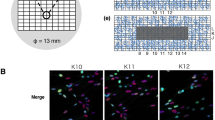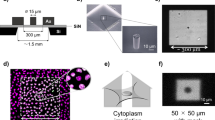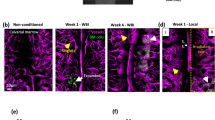Abstract
IT is known that ultra-violet irradiation may produce death of mammalian S3 HeLa strain cells1,2, strain D–98 and D–98C6b (ref. 3) and L strain4. In our previous work we found that the rate of synthesis of nucleic acids in irradiated L strain cells is much slower than in normal cells4. A similar phenomenon has been observed in ultra-violet-irradiated bacteria5,6. It is probable that some of the most important radiation effects are closely related to the damage of structure and function in nucleic acid (NA) macromolecules, which may be responsible for the modification of the genetic make-up of the cells and for their death. Therefore, the problem of the repair of this damage is one of the most important in radiobiology. Thus, we have paid special attention to the problem of the recovery of irradiated organisms, investigating the macromolecular basis of the phenomena. For this purpose, irradiated cells were treated with highly polymerized isologous deoxyribonucleic acid (DNA), and results presented in this communication show that the irradiated cells survive better if they are treated after irradiation.
This is a preview of subscription content, access via your institution
Access options
Subscribe to this journal
Receive 51 print issues and online access
$199.00 per year
only $3.90 per issue
Buy this article
- Purchase on SpringerLink
- Instant access to full article PDF
Prices may be subject to local taxes which are calculated during checkout
Similar content being viewed by others
References
Puck, T. T., Prog. Biophys., 10, 238 (1960).
Lee, H. H., and Puck, T. T., Rad. Res., 12, 340 (1960).
Moser, H., and Tomizawa, K., Ann. Rep. Biol. Lab. Cold Spring Harbor, N.Y., 33 (1957–58).
Kostić, Lj., Čećuk, O., and Kanazir, D., Bull. Inst. Nucl. Sci. ‘Boris Kidric’, 2, 209 (1961).
Kanazir, D., thesis, Univ. Libre de Bruxelles (1955).
Kanazir, D., and Errera, M., Cold Spring Harbor Symp., 21, 19 (1956).
Sanford, K. K., Earle, W. A., and Likely, G. D., J. Nat. Cancer Inst., 9, 229 (1948).
Eagle, H., Science, 130, 422 (1959).
Shugar, D., The Nucleic Acids, III, 49 (Academic Press, Inc., New York and London, 1960).
Zamenhof, S., and Reiner, B., J. Biol. Chem., 219, No. 1 (1956).
Pantić, V., Stošić, N., Kanazir, D., Bećarević, A., and Jovicki, G., Nature, 194, 942 (1962).
Author information
Authors and Affiliations
Rights and permissions
About this article
Cite this article
DJORDJEVIĆ, O., KOSTIĆ, L. & KANAZIR, D. Recovery of Ultra-Violet-irradiated L Strain Cells by means of Highly Polymerized Deoxyribonucleic Acid. Nature 195, 614–615 (1962). https://doi.org/10.1038/195614a0
Issue date:
DOI: https://doi.org/10.1038/195614a0
This article is cited by
-
Influence of exogenous DNA on Ypenyl-treated chromosomes ofVicia faba L.
Biologia Plantarum (1969)



